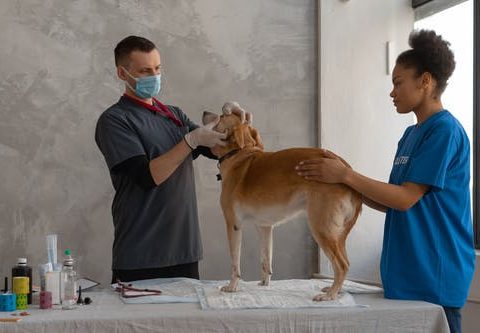Dogs, like humans, may suffer from infections and inflammation of their eyes. Infections rooted in bacteria or viruses can affect your dog’s eyes. Additionally, the irritants may cause inflammation. It’s crucial to make up an appointment to see your veterinarian figure out the cause. They’ll know whether a root cause caused your dog’s eye to get infected.
Maintaining your dog’s comfort and eye health requires correct treatment and care for their eye infection and other underlying problems. It may be essential for you to give one or several medications into an affected eye(s) to assist in healing.
How to Make Eye Treatment Administration for Your Pet Easier?
If your dog is suffering from inflammation or eye infection, you will most likely need to give him eye medication. However, your dog may resist this need because he does not comprehend why it is necessary to apply something to his already-irritated eye. You also do not have a way of explaining it to him. A few of the techniques you may use are provided below.
1. Ask for a demonstration from the Vet.
One of the initial steps is having the clinics like Northwest Animal Eye Specialists or nurses demonstrate how to administer the drops. They may have some special tricks that your pet will accept quite well. The simple act of learning ways to apply the medication and also how to keep eyes open and keep the dog’s head still may be really beneficial. It’s not an effortless task, and it requires some practice.
2. Prepare the medication beforehand.
When you’re administering eye drops, you would like to keep the process as simple and trouble-free as possible for both of you. You must remove the bottle’s lid and any caps with protective seals that might have remained on the pipette. You’re ready to proceed after determining that the fluid will flow.
It’s also important to know that certain eye drops are suspended; that’s why it’s important to shake the container for 10-20 seconds before use. Warming the medicine can make it less uncomfortable for your pet.
If the symptoms or manifestations persist, you need to immediately address these common conditions. In order to avoid a more severe ailment.
3. Call for an assistant if required.
You’ll need to position your dog to administer eye medications while keeping the dog in a steady position. The movement could result in the displacement of medication and the applicator coming into contact with the cornea’s surface and becoming contaminated or worse, causing harm to the cornea.
If an assistant is on hand, it may be beneficial to have someone else hold your dog’s head while you administer eye medications. If you want expert help, you can consider facilities like Kirkland animal hospital. Assuring the proper administration of medicine will also ensure your pet’s road to recovery.
4. Apply gentle restrictions.
She’ll typically fight with you if you attempt to restrain your dog. They realize that if they are held, something might occur, and it usually ends up being a battle instead of a simple way out, and you generally get the opposite of what you’re hoping for. Utilizing strategies based upon natural behavioral responses results in increased compassion and comprehension of the animal and an increased chance of success.
When you work to eliminate signs that animals may consider to be hostile or threatening, it increases the chances of success and safety.
5. Provide a reward.
Positive reinforcement means rewarding desirable actions through food or praise, toys, or anything else the dog can enjoy. Positive reinforcement is among your most effective strategies to influence or alter your dog’s behavior, as it encourages them to redo the behavior. Reward your dog with an occasional treat following every successful administration of eye medicine.
The dog will associate it with anything that is nice due to this. Whatever you’re feeling, make sure to remain as tranquil as you can for your pet and you.








